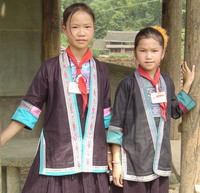
The making of traditional costumes continues to play an important role in a women's life. Each Dong dress group has its own traditions and produces distinct clothing that reflects its particular customs, history and beliefs. Cultural identity is thus maintained through the making and wearing of such garments.
Festivals and especially market days reveal the wide array of dress differences found among the Dong people. Much can be gleaned from one glance at a woman's costume as to not only where she comes from, but also how diligent she is as a worker and how creative an artist. For this reason, young women continue to learn from their mothers and grandmothers the technical intricacies of weaving long-cherished patterns into their cloth, the tedious hours of dyeing fabric to perfection, the ability to spin a fine thread and the patient skill needed to elaborately embroider garments. In some Dong areas, years of labor go into the making of one complete festive and marriage costume.
Another factor is responsible for the preservation of ancient textile techniques, styles and motifs-a woman's chances of marriage are closely aligned to her textile skills. One of the criteria a Dong man looks for in a prospective wife is her proficiency in embroidery, dyeing and weaving. A young girl begins learning the textile arts at the age of seven or eight, so by the time she reaches marriageable age, she'll have prepared one or more sets of festive clothing, painstakingly created to show her ability. The countless hours of needlework are exhibited during the many courting festivals held throughout the year, when women parade their most exquisite handmade costumes in the hope of attracting a desirable young man.
In the south, both festive and everyday wear are woven from cotton grown in nearly fields. The spinning wheel, an indispensable item of a woman's dowry, is found on the spacious wooden porch of the Dong's sturdy fir house, where women gather together to spin smooth cotton they weave will be transformed, through dyeing, into a unique iridescent fabric.
From the age of 13, Dong women working on floor looms produce yards of plain-woven cloth to be used in traditional clothing. The Dong are famous for their coloring brocade weavings that are incorporated into aprons, shoulder bags, baby-carriers and household items. The most common brocade motifs are camellias, human figures, animals and geometric patterns. Both floor looms and small belt looms are used to weave narrow bands of simple yet beautiful designs for straps and apron ties. In Guizhou's Congjiang and Liping counties, women weave delicate designs on low foot-pull body-tension looms containing over 300 supplemental harness sticks.
Jackets, trousers, leggings, finely pleated skirts, backless under-aprons and baby carriers are traditionally made from any one of three basic-dyed fabrics: an almost black indigo-dyed cloth; a stiff reddish-purple cloth, dyed first in indigo, then pounded with a mixture of cow's hide and blood; and a fabric dyed with the previous method, yet further coated with a mixture of egg whites, producing a lasting high-gloss sheen.
It is in the remote south where needlework of exquisite beauty, workmanship and variety can be found among the Dong people.
On sweltering summer days, Dong women (some as young as seven) sit on low stools mountain brooks under the shade of roofed "wind and rain" bridges, embroidering intricate designs on strips of white cloth-handwoven from threads finely spun from cotton grown in nearby fields. Any spare moment is caught to add a few more inches to their embroidered edgings and squares used to decorate bags (worn at the waist), baby carriers, apron yokes and jacket sleeves.
Dong Villages
Zhaoxing Tang'An Chengyang
Culture of Dongs
Sanyuejie Festival Marriage Customs Music New Year Traditional costumes
Drum Towers Flower Bridges Lusheng Festival
Dong Houses Carrying the Governors Parade
Drama Rice Planting Traditional Common Law Worship the Goddess Sa Sui
|